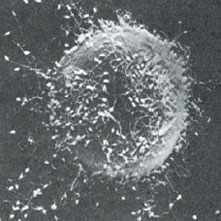Prevention of Polyspermy
Prevention of Polyspermy
At the point of sperm contact with the
egg vitelline envelope a fertilization
cone appears into which the sperm
head is later drawn (see Figure 8-4).
This event is followed immediately by
important changes in the egg surface
that block the entrance of additional
sperm, which, in marine eggs especially,
may quickly surround the egg in swarming
numbers (Figure 8-5). The entrance
of more than one sperm, called polyspermy, must be prevented
because the union of more than two
haploid nuclei would be ruinous for
normal development. In a sea urchin
egg, contact of the first sperm with the
egg membrane is instantly followed by
an electrical potential change in the egg
membrane that prevents additional
sperm from fusing with the membrane.
This event, called the fast block, is followed
immediately by the cortical
reaction, in which thousands of
enzyme-rich cortical granules, located
just beneath the egg membrane, fuse
with the membrane and release their
contents into the space between the egg
membrane and the overlying vitelline
envelope (see Figure 8-4). The cortical
reaction creates an osmotic gradient,
causing water to rush into this space,
elevating the envelope and lifting away
all sperm bound to it, except the one
sperm that has successfully fused with
the egg membrane. One of the cortical
granule enzymes causes the vitelline
envelope to harden, and it is now called
a fertilization membrane. The block
to polyspermy is complete. The timing
sequence of these early events is summarized
in Figure 8-6. Mammals have a
similar security system that is erected
within seconds after the first sperm fuses
with the egg membrane.
 |
| Figure 8-5 Binding of sperm to the surface of a sea urchin egg. Only one sperm penetrates the egg surface, the others being blocked from entrance by rapid changes in the egg membranes. Unsuccessful sperm are soon lifted away from the egg surface by a newly formed fertilization membrane. |




